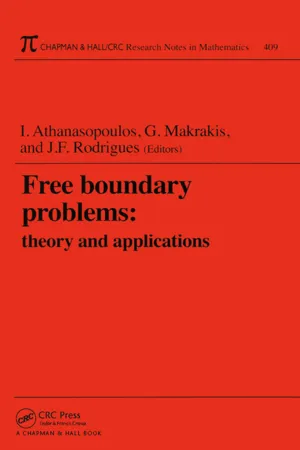
- 368 pages
- English
- ePUB (mobile friendly)
- Available on iOS & Android
About This Book
Free boundary problems arise in an enormous number of situations in nature and technology. They hold a strategic position in pure and applied sciences and thus have been the focus of considerable research over the last three decades. Free Boundary Problems: Theory and Applications presents the work and results of experts at the forefront of current research in mathematics, material sciences, chemical engineering, biology, and physics. It contains the plenary lectures and contributed papers of the 1997 International Interdisciplinary Congress proceedings held in Crete.
The main topics addressed include free boundary problems in fluid and solid mechanics, combustion, the theory of filtration, and glaciology. Contributors also discuss material science modeling, recent mathematical developments, and numerical analysis advances within their presentations of more specific topics, such as singularities of interfaces, cusp cavitation and fracture, capillary fluid dynamics of film coating, dynamics of surface growth, phase transition kinetics, and phase field models.
With the implications of free boundary problems so far reaching, it becomes important for researchers from all of these fields to stay abreast of new developments. Free Boundary Problems: Theory and Applications provides the opportunity to do just that, presenting recent advances from more than 50 researchers at the frontiers of science, mathematics, and technology.
Frequently asked questions
Information
Part 1.
Plenary Lectures
L. BADEA, R. E. EWING, AND J. WANG*
A Study of Free Boundary Problems of Fluid Flow in Porous Media by Mixed Methods
Abstract
1 Introduction
Table of contents
- Cover
- Half Title
- Series Page
- Title Page
- Copyright Page
- Table of Contents
- Preface
- Part 1. Plenary Lectures
- Part 2. Mathematical Developments of Free Boundary Problems
- Part 3. Free Boundary Problems in Fluid Mechanics
- Part 4. Phase Change in Material Science
- Part 5. Computational Methods and Numerical Analysis